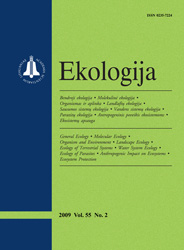 ISSN 0235-7224 ISSN 2029-0586 (online) |
2008 m. Nr. 1 The impact of lime on water quality when draining clay soils
One of the tasks of environmental protection is to achieve a good ecological status of water bodies and reduce agricultural non-point pollution. Since drainage outflow may be identified as the leading source of water quality, reduction of nutrient transport through drains is of great importance. Field studies of the impact of lime admixture in trench backfill on the content of phosphorus and nitrogen in drainage outfl ow and the Šilupė stream water were conducted in the Kalnujai site (Raseiniai distr.) located in South-western Lithuania. Heavy-textured clay loam soils were drained by a composite subsurface drainage system with drain spacings of 16 and 24 m. To improve water permeability, drainage trenches were backfilled with soil mixed with 0.6% CaO. Results of sevenyear studies (1999–2005) on water quality are reported in the paper. Water samples were analysed for total phosphorus (TP), phosphate phosphorus (PO4–P), nitrate nitrogen (NO3–N) and ammonia nitrogen (NH4–N). Significant differences in the PO4–P concentrations in the control drainage outfl ow and treatments with lime added to trench backfill were estimated. In the water of the control drainage, these concentrations were found to be 2.8 times higher. Lime admixture reduces the annual load of TP and PO4–P two and three times respectively as compared with the conventional drainage system. A slightly decreasing trend of TP (r = 0.49) and PO4–P (r = 0.54) concentrations was determined in the stream where drainage water is discharged. As regards nitrogen concentrations, the diff erences in drainage treatments were insignificant. The improved drainage trench backfill permeability did not increase NO3–N leaching to drainage water; however, NO3–N concentrations in the Šilupė stream were higher compared with rivers of natural background level pollution. Th e increase in agricultural activities enhanced NO3–N concentrations in drainage water and thereby the NO3–N input to the stream. Keywords: drainage, trench backfi ll, liming, water quality, phosphorus, nitrogen |
Issues:
2011 - Vol.57 No. 1, No. 2 2010 - Vol.56 No. 1-2, No. 3-4 2009 - Vol.55 No. 1, No. 2, No. 3-4 2008 - Vol.54 No. 1, No. 2, No. 3, No. 4 2007 - Vol.53 No. 1, No. 2, No. 2.priedas, No. 3, No. 4 2006 No. 1, No. 2, No. 3, No. 4 2005 No. 1, No. 2, No. 3, No. 4 2004 No. 1, No. 2, No. 3, No. 4 2003 No. 1, No. 2, No. 3, No. 4 2002 No. 1, No. 2, No. 3, No. 4 2001 No. 1, No. 2, No. 3, No. 4 |